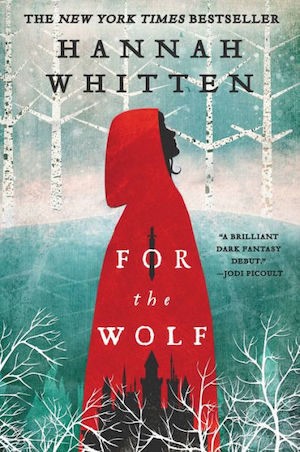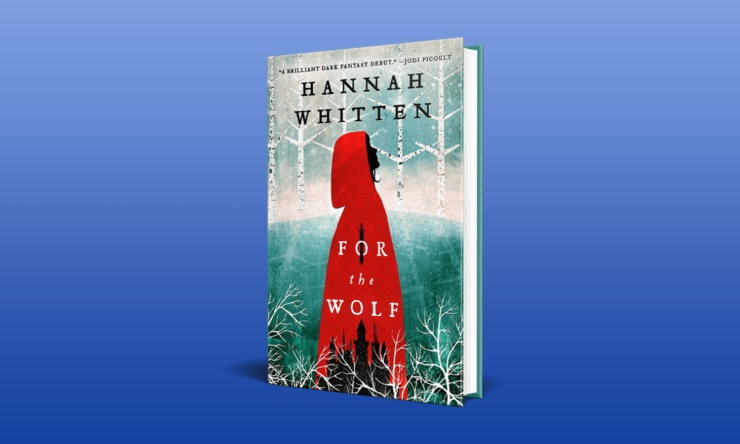There’s a red cape and a forest and a wolf, but Hannah Whitten’s debut novel For the Wolf isn’t just a Little Red Riding Hood retelling. It is a story about a young woman named Red who goes into a dark forest where a Wolf lurks. But the familiar imagery is a means, not an end. Whitten isn’t tweaking one fairy tale, or even a cluster of them. She’s borrowing pieces and ideas and images to stitch together a whole new red cloak, a story that understands how powerful fairy tales are—and how misused that power can be.
Twin sisters Red and Neve are the daughters of the Queen of Valleyda, and their fates were decided before they were born. The First Daughter is for the throne, destined to follow in her mother’s footsteps. But the Second Daughter is for the Wolf, a sacrifice to the creature who lives in the Wilderwood. The wood is not just a cluster of trees, but a boundary and a guardian—one that must be maintained to “hold fast against the things bound beneath.”
This tithe is the result of an ancient bargain that has, in the centuries since its origin, taken on the ritual and weight of religion. Once upon a time, a deal was struck with the Wilderwood, and there is no escaping it, no matter how much Neve begs her sister to run. Red has known her purpose since she was old enough to understand the story, and she will grit her teeth and pour wine down her throat and do what she must, because if she stays, she endangers everyone she loves.
Buy the Book


For the Wolf
But the threat that Red sees in herself—a tangle of magic she doesn’t understand—isn’t what she thinks it is. Neither is the Wilderwood, and neither is the Wolf. And once one part of the ancient story begins to unravel, well, you can begin to see how the whole tapestry might come apart.
For the Wolf is a distant cousin to Naomi Novik’s Uprooted, which also follows a magic-touched young woman sent to live with a man who’s thought to be a monster. Novik’s Agnieszka leaves behind her best friend, saving her from the Dragon; Red leaves behind her beloved sister, thinking she’s saving Neve from the magic Red can’t always control.
But Neve wants to save Red, too, and will go to her own great lengths to do so. One of the things Whitten wrestles with here is the whole concept of saving someone: What choice do they have in the matter? What if rescue looks like something else to a person who isn’t really a victim? What if trying to sacrifice yourself for the people you love only makes things worse? The shifts of power between the twins drive this book as much as any old stories do: two girls trying to live up to expectations and make their own choices, when those things may be utterly incompatible.
Whitten is working with familiar tools: the magic, creepy forest is a staple of fantasy, and this one, full of thorns, recalls not just the woods in which Little Red Riding Hood encounters a wolf, but the spiky walls around Sleeping Beauty’s castle. A glass coffin that appears late in the book suggests Snow White; there’s no wicked stepmother here, but there is a conniving, powerful priestess who’d like Neve’s mother out of the way. A Green Man thread twines throughout, a connection between Wolf and Wilderwood. The imagery is alluringly familiar, and all the more so as Whitten re-spins it to her own ends. She uses repetition the way an old story would, coming back to the white trees, the green that runs in Red’s veins when her magic sparks, the scent of books, the dark of twilight, the roughness of bark. There’s a visceral quality to the way Red moves through her world, always aware of her body, her fragility in contrast to the Wilderwood’s magic.
The story of the original bargain with the Wilderwood is never told at once. Whitten takes her time with the history of her world, with the details of the bargain, the stories of other Second Daughters, the needs and purposes of the Wilderwood itself. She lets unease build until we have no choice to see the founding myth of her world in an entirely different light.
Under the romance and behind the shadow-monsters, For the Wolf is a fairy tale about the way stories can guide and ruin us. They can teach, soothe, explain—and they can be weapons, wielded as power, used as control, turned destructively simple when the reality is nuanced and complicated. The story that defines Red and Neve’s life is true and not true at once. It’s a calcified, codified version of what really happened—a version useful for keeping the powers that be in power, keep the Queen on her throne, the High Priestess in her Shrine, the other countries paying prayer-taxes and showing their gratitude. And all it takes is the sacrifice of one girl who has no say in the matter.
What Whitten does is give Red her say—her choice, her power, and her freedom. She links the imagery of fairy tales to the ugly realities of power, complicating things, letting people make their own choices about what they give up and what they hold on to tightly. If you have fairy tales in your blood, you might feel this story deep in your childhood heart. It settles there alongside the stories you know, but its edges are different, and it calls for much more blood than the prick of a spindle.
It’s not all blood and shadows; Whitten builds her central romance carefully and lightly, letting the stress of the Wilderwood—and the stubbornness of both parties—provide much of the angst. For the Wolf is a long trek through a dangerous, bloodthirsty wood where few things are as they seem. It’s a haunting, beautifully told tale, and one that’s not over yet: The sequel, For the Throne, is due out next year. It’s going to be a long wait.
For the Wolf is available from Orbit.
Molly Templeton lives and writes in Oregon, and spends as much time as possible in the woods. You can also find her on Twitter.










